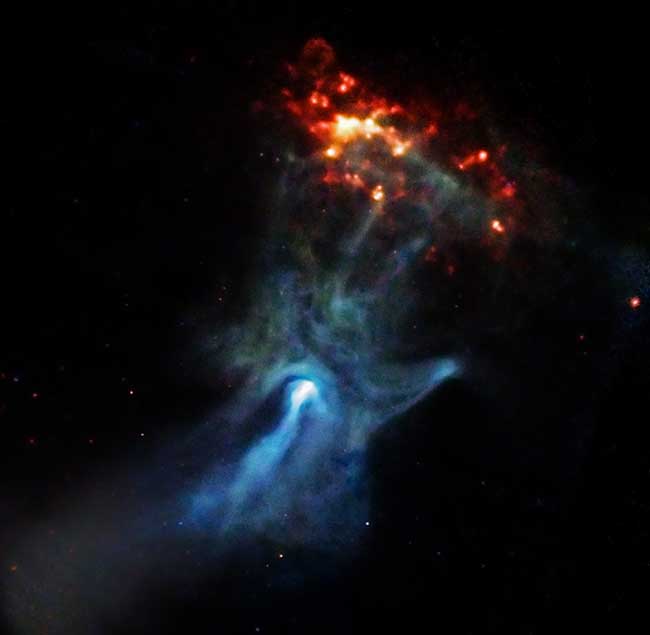| 5-31-09 - New sunspot emerging on far left side
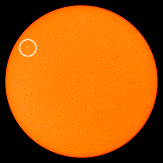
A new sunspot is emerging at the
circled location. Its high latitude suggests it is a member of new Solar
Cycle 24. Credit: SOHO/MDI
more images:
from Peter Paice of Belfast, Northern Ireland;
from Cai-Uso Wohler of Bispingen, Germany;
from Howard Eskildsen of Ocala, Florida
Current conditions
Solar wind
speed: 332.2 km/sec
density: 1.3 protons/cm3
explanation |
more
data
Updated: Today at
2345 UT
X-ray Solar Flares
6-hr max: A1
2055 UT May31
24-hr: A1
2055 UT May31
explanation |
more
data
Updated: Today at:
2340 UT
|
5-30-09 - No sunspots today
Current conditions
Solar wind
speed: 345.0 km/sec
density: 1.1 protons/cm3
explanation |
more
data
Updated: Today at
2345 UT
X-ray Solar Flares
6-hr max: A0
2340 UT May30
24-hr: A0
1245 UT May30
explanation |
more
data
Updated: Today at:
2340 UT
New Solar Cycle Prediction 05.29.2009
May 29, 2009: An international panel of experts led
by NOAA and sponsored by NASA has released a new prediction for the
next solar cycle. Solar Cycle 24 will peak, they say, in May 2013 with
a below-average number of sunspots.
 "If
our prediction is correct, Solar Cycle 24 will have a peak sunspot
number of 90, the lowest of any cycle since 1928 when Solar Cycle 16
peaked at 78," says panel chairman Doug Biesecker of the NOAA Space
Weather Prediction Center. "If
our prediction is correct, Solar Cycle 24 will have a peak sunspot
number of 90, the lowest of any cycle since 1928 when Solar Cycle 16
peaked at 78," says panel chairman Doug Biesecker of the NOAA Space
Weather Prediction Center.
Right: A solar flare observed in Dec. 2006 by NOAA's GOES-13
satellite.
It is
tempting to describe such a cycle as "weak" or "mild," but that could
give the wrong impression.
"Even a
below-average cycle is capable of producing severe space weather,"
points out Biesecker. "The great geomagnetic storm of 1859, for
instance, occurred during a solar cycle of about the same size we’re
predicting for 2013."
The
1859 storm--known as the "Carrington Event" after astronomer Richard
Carrington who witnessed the instigating solar flare--electrified
transmission cables, set fires in telegraph offices, and produced
Northern Lights so bright that people could read newspapers by their
red and green glow. A recent report by the National Academy of
Sciences found that if a similar storm occurred today, it could cause
$1 to 2 trillion in damages to society's high-tech infrastructure and
require four to ten years for complete recovery. For comparison,
Hurricane Katrina caused "only" $80 to 125 billion in damage.

Above: This plot of sunspot numbers shows the measured peak
of the last solar cycle in blue and the predicted peak of the next
solar cycle in red. Credit: NOAA/Space Weather Prediction Center. [more]
The latest
forecast revises an earlier prediction issued in 2007. At that time, a
sharply divided panel believed solar minimum would come in March 2008
followed by either a strong solar maximum in 2011 or a weak solar
maximum in 2012. Competing models gave different answers, and
researchers were eager for the sun to reveal which was correct.
"It turns
out that none of our models were totally correct," says Dean Pesnell
of the Goddard Space Flight Center, NASA's lead representative on the
panel. "The sun is behaving in an unexpected and very interesting
way."
Researchers have known about the solar cycle since the mid-1800s.
Graphs of sunspot numbers resemble a roller coaster, going up and down
with an approximately 11-year period. At first glance, it looks like a
regular pattern, but predicting the peaks and valleys has proven
troublesome. Cycles vary in length from about 9 to 14 years. Some
peaks are high, others low. The valleys are usually brief, lasting
only a couple of years, but sometimes they stretch out much longer. In
the 17th century the sun plunged into a 70-year period of spotlessness
known as the Maunder Minimum that still baffles scientists.

Above: Yearly-averaged sunspot numbers from 1610 to 2008.
Researchers believe upcoming Solar Cycle 24 will be similar to the
cycle that peaked in 1928, marked by a red arrow. Credit: NASA/MSFC
Right now,
the solar cycle is in a valley--the deepest of the past century. In
2008 and 2009, the sun set Space Age records for low sunspot counts,
weak solar wind, and low solar irradiance. The sun has gone more than
two years without a significant solar flare.
"In our
professional careers, we've never seen anything quite like it," says
Pesnell. "Solar minimum has lasted far beyond the date we predicted in
2007."
In
recent months, however, the sun has begun to show timorous signs of
life. Small sunspots and "proto-sunspots" are popping up with
increasing frequency. Enormous currents of plasma on the sun’s surface
("zonal flows") are gaining strength and slowly drifting toward the
sun’s equator. Radio astronomers have detected a tiny but significant
uptick in solar radio emissions. All these things are precursors of an
awakening Solar Cycle 24 and form the basis for the panel's new,
almost unanimous forecast.
According
to the forecast, the sun should remain generally calm for at least
another year. From a research point of view, that's good news because
solar minimum has proven to be more interesting than anyone imagined.
Low solar activity has a profound effect on Earth’s atmosphere,
allowing it to cool and contract. Space junk accumulates in Earth
orbit because there is less aerodynamic drag. The becalmed solar wind
whips up fewer magnetic storms around Earth's poles. Cosmic rays that
are normally pushed back by solar wind instead intrude on the
near-Earth environment. There are other side-effects, too, that can be
studied only so long as the sun remains quiet.
Meanwhile,
the sun pays little heed to human committees. There could be more
surprises, panelists acknowledge, and more revisions to the forecast.
"Go ahead
and mark your calendar for May 2013," says Pesnell. "But use a
pencil."
Author:
Dr. Tony Phillips | Credit:
Science@NASA
more information
Deep Solar Minimum -- (Science@
|
5-29-09 - No sunspots today
Current conditions
Solar wind
speed: 396.8 km/sec
density: 0.7 protons/cm3
explanation |
more
data
Updated: Today at
2346 UT
X-ray Solar Flares
6-hr max: A0
2340 UT May29
24-hr: A0
1235 UT May29
explanation |
more
data
Updated: Today at:
2340 UT SOLAR
ACTIVITY: NASA's
STEREO-B
spacecraft, stationed over the sun's eastern horizon, is
tracking a new active region. It is circled in this
extreme ultraviolet image transmitted from STEREO-B just
hours ago:
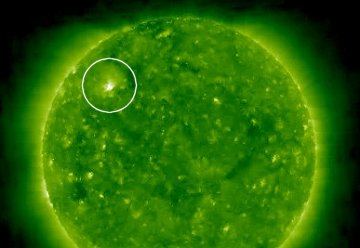
The high-latitude of the region suggests it is a
manifestation of new Solar Cycle 24. If so, this would
continue a May trend of intensifying new-cycle activity.
The active region is probably a proto-sunspot--a knot of
magnetism struggling to form a fully-realized
dark core. We'll know for sure in the next day or so
when the hot spot turns to face Earth. Readers with
solar telescopes, point your optics at the
northeastern limb.
|
5-28-09 - No sunspots today
Current conditions
Solar wind
speed: 399.5 km/sec
density: 1.0 protons/cm3
explanation |
more
data
Updated: Today at
2345 UT
X-ray Solar Flares
6-hr max: A0
2340 UT May28
24-hr: A0
2340 UT May28
explanation |
more
data
Updated: Today at:
2340 UT
|
5-27-09 - No sunspots today Current conditions
Solar wind
speed: 277.2 km/sec
density: 0.4 protons/cm3
explanation |
more data
Updated: Today at 2118 UT
X-ray Solar Flares
6-hr max: A0 2120 UT
May27
24-hr: A0 0100 UT
May27
explanation |
more data
Updated: Today at: 2120 UT
|
5-26-09 - No sunspots today
Current conditions
Solar wind
speed: 301.4 km/sec
density: 0.4 protons/cm3
explanation |
more
data
Updated: Today at
2344 UT
X-ray Solar Flares
6-hr max: A0
2025 UT May26
24-hr: A0
2025 UT May26
explanation |
more
data
Updated: Today at:
2340 UT
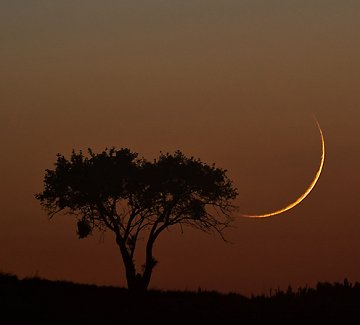
|
5-25-09 - No sunspots today
Current conditions
Solar wind
speed: 321.9 km/sec
density: 0.8 protons/cm3
explanation |
more
data
Updated: Today at
2345 UT
X-ray Solar Flares
6-hr max: A0
2340 UT May25
24-hr: A0
2340 UT May25
explanation |
more
data
Updated: Today at:
2340 UT
|
5-24-09 - There are no sunspots today
Current conditions
Solar wind
speed: 347.5 km/sec
density: 0.6 protons/cm3
explanation |
more data
Updated: Today at 0936 UT
X-ray Solar Flares
6-hr max: A0 0935 UT
May24
24-hr: A0 0935 UT
May24
explanation |
more data
Updated: Today at: 0935 UT
|
| 5-23-09 - A sunspot emerged by lasted only a day sunspot #11
???- How sunspots are numbered -
http://spaceweather.com/glossary/sunspotnumber.html
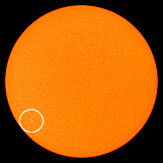 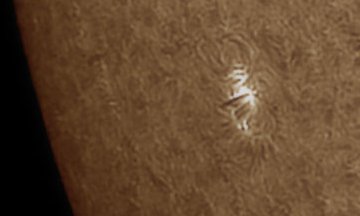
NEW SUNSPOT:
Magnetic fields are emerging from
beneath the sun's surface to form a new sunspot near the
southeastern limb. "It looks a little angry," says Pete
Lawrence, who photographed the active region on May 22nd
from his backyard observatory in Selsey UK:
The magnetic polarity of the sunspot identifies it as a
member of new Solar Cycle 24, which forecasters expect to
peak in May 2013. That makes this little spot a herald of
things to come. Readers with
solar telescopes, take a look; today you can see
sunspot genesis in action.
more images:
from N. Lavoie and J. Stetson of South Portland,
Maine;
from Cai-Uso Wohler of Bispingen, Germany;
from Didier Favre of Brétigny sur Orge, France;
from Christophe Behaegel of Vilvoorde, Belgium;
from Keith Davies of Swansea, South Wales, UK;
from Günther Strauch of Borken, NRW, Germany;
from Mike Borman of Evansville, Indiana;
Current conditions
Solar wind
speed: 372.3 km/sec
density: 1.9 protons/cm3
explanation |
more
data
Updated: Today at
2339 UT
X-ray Solar Flares
6-hr max: A0
1920 UT May23
24-hr: A0
0735 UT May23
explanation |
more
data
Updated: Today at:
2340 UT
|
| 5-22-09 sunspot appears - see 5-23-09 for more pictures. They are
calling this sunspot 11, though the last one was number 12.
DARK
FILAMENT: Astronomers are
monitoring a dark filament of magnetism on the sun. "The
filament is very dynamic and a tremendous amount of detail
can be seen," reports observer Pete Lawrence. He made
this movie and took the picture below using a
SolarScope SF-70 at his backyard observatory in Selsey UK.
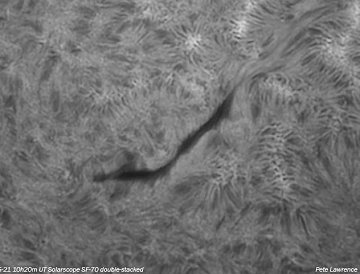
The dark material in the filament is a mixture of
hydrogen and helium gas, seemingly dark because it is
cooler than the inferno below. In fact, if you could hold
the filament up against the night sky, it would glow fiery
red with the luminosity of a full Moon, Sometimes
filaments become unstable and collapse. When they crash
down onto the surface of the sun, the result is a type of
solar flare called a
Hyder
flare. So far this filament is holding steady, which
means you still have time to observe it. Readers with
solar telescopes, point your optics
here.
more images:
from Didier Favre of Brétigny sur Orge, France;
from Christophe Behaegel of Vilvoorde, Belgium;
from Keith Davies of Swansea, South Wales, UK;
from Günther Strauch of Borken, NRW, Germany;
from Mike Borman of Evansville, Indiana;
Current conditions
Solar wind
speed: 394.5 km/sec
density: 0.2 protons/cm3
explanation |
more
data
Updated: Today at
2346 UT
X-ray Solar Flares
6-hr max: A0
2340 UT May22
24-hr: A0
0720 UT May22
explanation |
more
data
Updated: Today at:
2340 UT
|
5-21-09 - No sunspots today
Current conditions
Solar wind
speed: 335.8 km/sec
density: 1.0 protons/cm3
explanation |
more
data
Updated: Today at
2345 UT
X-ray Solar Flares
6-hr max: A0
2340 UT May21
24-hr: A0
1215 UT May21
explanation |
more
data
Updated: Today at:
2340 UT
|
5-20-09 - No sunspots today -
Solar wind
speed: 332.8 km/sec
density: 3.5 protons/cm3
explanation |
more
data
Updated: Today at
2345 UT
X-ray Solar Flares
6-hr max: A0
2340 UT May20
24-hr: A0
2340 UT May20
explanation |
more
data
Updated: Today at:
2340 UT
|
| 5-19-09 Sunspot 1017 - They are numbering this sunspot #14
Note: I have no idea why the number changed from when it started.
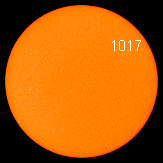
Fading sunspot group 1017
is a member of new Solar
Cycle 24. Credit: SOHO/MDI
Current conditions
Solar wind
speed: 278.0 km/sec
density: 1.2 protons/cm3
explanation |
more
data
Updated: Today at
2345 UT
X-ray Solar Flares
6-hr max: A0
2340 UT May19
24-hr: A0
0735 UT May19
explanation |
more
data
Updated: Today at:
2340 UT
|
5-18-09 - Sunspot 1017 is fading
Current conditions
Solar wind
speed: 299.6 km/sec
density: 0.2 protons/cm3
explanation |
more
data
Updated: Today at
2345 UT
X-ray Solar Flares
6-hr max: A0
1800 UT May18
24-hr: A0
1215 UT May18
explanation |
more
data
Updated: Today at:
2340 UT
CELESTIAL
TRIANGLE: This week, Venus, Mars
and the Moon are gathering for a morning sky show. On
Wednesday, May 20th, the three worlds will form a line in
the dawn sky. On Thursday morning, May 21st, they will
shift to become the vertices of a lovely celestial
triangle. Mark your calendar and set your alarm!
Sky maps:
May 20,
21
|
5-17-09 sunspot is a member of cycle 24 they have decided
Current conditions
Solar wind
speed: 295.8 km/sec
density: 0.2 protons/cm3
explanation |
more
data
Updated: Today at
2308 UT
X-ray Solar Flares
6-hr max: A0
2255 UT May17
24-hr: A0
0530 UT May17
explanation |
more
data
Updated: Today at:
2340 UT
|
| 5-16-09 - sunspot 1017 in center of sun - They are also calling this
sunspot 12
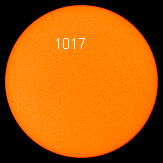
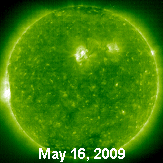
Sunspot group 1017 is a member of
new Solar Cycle 24. Credit: SOHO/MDI
Current conditions
Solar wind
speed: 388.9 km/sec
density: 0.6 protons/cm3
explanation |
more data
Updated: Today at 1254 UT
X-ray Solar Flares
6-hr max: A0 1255 UT
May16
24-hr: A0 1255 UT
May16
explanation |
more data
Updated: Today at: 1255 UT
|
| 5-15-09 sunspot 1017
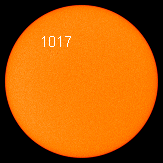
Current conditions
Solar wind
speed: 347.3 km/sec
density: 0.6 protons/cm3
explanation |
more
data
Updated: Today at
2345 UT
X-ray Solar Flares
6-hr max: A0
2340 UT May15
24-hr: A0
0230 UT May15
explanation |
more
data
Updated: Today at:
2340 UT
|
| 5-14-09 - Sunspot 1017 has appeared
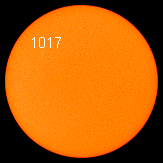
Scattered sunspot group 1017
materialized on May 13th from a formerly spotless active region. Its
magnetic polarity identifies it as a member of new Solar Cycle 24. Credit:
SOHO/MDI
Current conditions
Solar wind
speed: 385.6 km/sec
density: 2.6 protons/cm3
explanation |
more
data
Updated: Today at
2345 UT
X-ray Solar Flares
6-hr max: A0
1850 UT May14
24-hr: A4
0620 UT May14
explanation |
more
data
Updated: Today at:
2340 UT
|
| 5-13-09 - No sunspots, but we have magnetism spots
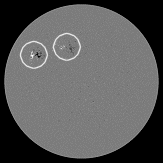
Today's image is a magnetic map of
the sun. Two active regions are circled. Their polarity identifies them as
members of new Solar Cycle 24, but they lack the dark cores required of
true sunspots. So, in spite of these lively magnetic imprints, we must
still say "the sun is blank--no sunspots." Credit: SOHO/MDI
Current conditions
Solar wind
speed: 342.0 km/sec
density: 0.7 protons/cm3
explanation |
more
data
Updated: Today at
2346 UT
X-ray Solar Flares
6-hr max: A0
2100 UT May13
24-hr: A0
1505 UT May13
explanation |
more
data
Updated: Today at:
2340 UT
HUBBLE
CAPTURED: "Hubble has arrived
onboard Atlantis!" That was the enthusiastic radio message
shuttle astronauts sent to Houston at 1:14 pm EDT today
after they had grappled Hubble using the shuttle's robotic
arm and started the process of berthing the telescope in
the shuttle's payload bay. The successful capture of
Hubble sets the stage for servicing. In the days ahead,
astronauts will conduct five spacewalks to repair and
upgrade the telescope, extending Hubble's operational life
until at least 2014.Minutes before Hubble was captured,
astronauts snapped this picture--the first close-up view
of the great telescope since March 2002:
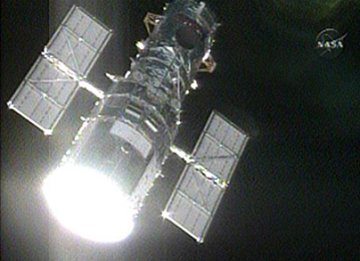
Both Atlantis and Hubble are visible to the unaided eye
when they pass overhead in the night sky. Check the
Simple Satellite Tracker to see if you are favored
with a flyby.
SHADOWS
VANISH IN INDIA: Today in Pune,
India, Anirudh
Walvekar stepped out of his office for lunch and
noticed something missing. "Our shadows were gone!" he
says. A second look revealed them to be merely underfoot:
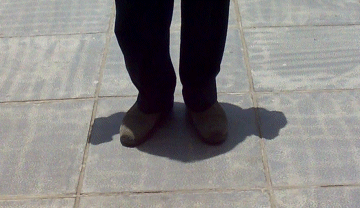
"On May 13, 2009, at 12:30pm local time, the sun was
directly above our heads in Pune, causing shadows to
disappear," he explains. In the language of astronomy, the
declination of the sun was +18.4 degrees, precisely equal
to the latitude of Pune. "This phenomenon occurs twice a
year, once in Spring when the sun passes overhead going
north, and again in Summer (July 30th) when it returns to
the south."
Tomorrow, May 14th, noon shadows will return to Pune,
but they will disappear somewhere else as the sun
continues its springtime journey north. If the latitude of
your hometown happens to be
+18.6
degrees, go outside on and look for your shadow. Hint:
Look underfoot.
|
| 5-12-09 - No sunspots - but we have magnetism seething
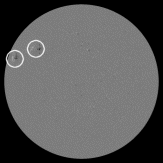
Today's image is a magnetic map of
the sun. Two active regions are circled. Their polarity identifies them as
members of new Solar Cycle 24, but they lack the dark cores required of
true sunspots. So, in spite of these lively magnetic imprints, we must
still say "the sun is blank--no sunspots." Credit: SOHO/MDI
NOT A
SUNSPOT: Solar activity comes in
many forms. Today, astronomers are monitoring an enormous
patch of seething magnetism churning through the sun's
surface in a splash of bright, white froth. It is not a
sunspot, but it is worth a look:
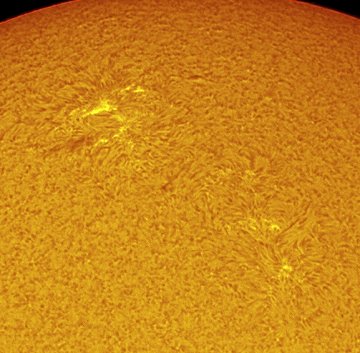
Sylvain Weiller took the picture this
morning from his backyard observatory in
Saint Rémy lès Chevreuse, France. "I used
a Colorado SolarMax90," he says. That is
an "H-alpha" telescope tuned to the red
glow of solar hydrogen.The active
region could be a "proto-sunspot"--a
sunspot struggling to form, but not quite
able to organize its own magnetic fields
into a coherent, dark core. Or it could be
a "sunspot corpse"--the decaying remains
of a farside sunspot turning toward Earth
at the end of its short life. Whatever it
is, its magnetic polarity identifies it as
a member of new Solar Cycle 24--and that
makes it a sign of
things to come.
more images:
from Marco of Stojnci, Slovenia;
from Andy Yeung of Hong Kong , China
Current conditions
Solar wind
speed: 313.8 km/sec
density: 1.9 protons/cm3
explanation |
more
data
Updated: Today at
2346 UT
X-ray Solar Flares
6-hr max: A0
2340 UT May12
24-hr: A1
0710 UT May12
explanation |
more
data
Updated: Today at:
2340 UT
|
| 5-11-09 No sunspots today Bright spots on the edge of the sun
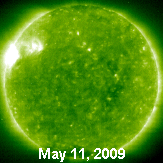
Current conditions
Solar wind
speed: 364.4 km/sec
density: 1.3 protons/cm3
explanation |
more
data
Updated: Today at
2346 UT
X-ray Solar Flares
6-hr max: A4
2305 UT May11
24-hr: A4
2305 UT May11
explanation |
more
data
Updated: Today at:
2340 UT
|
5-10-09 - No sunspots today
Current conditions
Solar wind
speed: 415.9 km/sec
density: 1.9 protons/cm3
explanation |
more
data
Updated: Today at
2346 UT
X-ray Solar Flares
6-hr max: A0
2020 UT May10
24-hr: B1
1215 UT May10
explanation |
more
data
Updated: Today at:
2340 UT
SATELLITE COLLISION:
On
Feb. 10th, 2009, Iridium 33 collided with
Cosmos 2251 over northern Siberia, and the two
satellites were shattered. US Strategic
command has since catalogued 981 pieces of
debris, 25 of which have already reentered
Earth's atmosphere. On this three-month
anniversary of the collision, veteran
satellite observer Daniel Deak has prepared a
set of 3D orbital debris maps. Broswe the
links to see where the fragments are located
on May 10, 2009: Iridium 33:
#1,
#2,
#3, Cosmos 2251:
#1,
#2,
#3.BONUS: A large
piece of Iridium 33 wreckage is visible to the
naked eye as it tumbles through the night sky
flashing every 4.7 seconds. Check the
Simple Satellite Tracker for flyby times.
SOLAR RADIO BURST:
On May 9th at 1614 UT,
the sun emitted a strong shortwave radio
burst. Amateur astronomer Thomas Ashcraft
recorded
the event using a 21 MHz radio telescope
in New Mexico. Click on the image to listen:
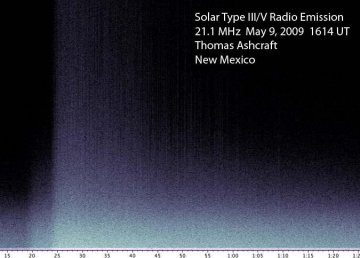
The loud swishing sound you
just heard is a combo
Type III-Type
V solar radio burst caused by electron
beams moving through the sun's outer
atmosphere. The source of the electrons is
probably an active region
now emerging over the sun's eastern limb.
The unnumbered region is crackling with
low-level
A- and B-class solar flares, and it could
produce more radio sounds in the days ahead.
Ham radio operators, point your
Yagis toward the sun!
more images:
from Jesper Sorensen of Kastrup, Denmark;
from Mike Borman of Evansville, Indiana;
from Peter Paice of Belfast, Northern
Ireland;
from Lars Zielke of Tvis Denmark;
from Cai-Uso Wohler of Bispingen, Germany;
from Guenter Kleinschuster of Feldbach,
Austria;
from P-M Hedén of Vallentuna, Sweden;
from Pete Lawrence of Selsey, West Sussex,
UK;
from Stephen Ames of Hodgenville,
Kentucky;
from Mike Strieber of Las Vegas, Nevada;
from Sylvain Weiller of Saint Rémy lès
Chevreuse, France
|
5-9-09 - No sunspots today
Current conditions
Solar wind
speed: 432.1 km/sec
density: 1.3 protons/cm3
explanation |
more data
Updated: Today at 2336 UT
X-ray Solar Flares
6-hr max: A2 1945 UT
May09
24-hr: B1 0130 UT
May09
explanation |
more data
Updated: Today at: 2330 UT
NOTE: Wonder what happened to the scary scenario that the scientists
came up with toward the end of cycle 23 that said it was going to be the
worst ever and would kill all the satellites, etc.
NOAA PREDICTS SOLAR
CYCLE 24: Today, an international panel of
experts led by NOAA issued a new prediction for Solar Cycle 24: It
will peak, they say, in May of 2013 with a below-average sunspot
number of 90:
NOAA Predicts Solar Cycle 24
May 8, 2009: A new active period of
Earth-threatening solar storms will be the weakest since
1928 and its peak is still four years away, after a slow
start last December, predicts an international panel of
experts led by NOAA's Space Weather Prediction Center.
Even so, Earth could get hit by a devastating solar storm
at any time, with potential damages from the most severe
level of storm exceeding $1 trillion. NASA funds the
prediction panel.
Solar storms are eruptions of energy and matter that
escape from the sun and may head toward Earth, where even
a weak storm can damage satellites and power grids,
disrupting communications, the electric power supply and
GPS. A single strong blast of solar wind can threaten
national security, transportation, financial services and
other essential functions.
The panel predicts the upcoming Solar Cycle 24
will peak in May 2013 with a daily sunspot number
of 90. If the prediction proves true, Solar Cycle 24 will
be the weakest cycle since number 16, which peaked at 78
daily sunspots in 1928, and ninth weakest since the 1750s,
when numbered cycles began.
The most common measure of a solar cycle’s intensity is
the number of sunspots—Earth-sized blotches on the sun
marking areas of heightened magnetic activity. The more
sunspots there are, the more likely it is that solar
storms will occur, but a major storm can occur at any
time.
"As with hurricanes, whether a cycle is active or weak
refers to the number of storms, but everyone needs to
remember it only takes one powerful storm to cause
expensive problems," said NOAA scientist Doug Biesecker,
who chairs the panel. "The strongest solar storm on record
occurred in 1859 during another below-average cycle
similar to the one we are predicting."
The 1859 storm shorted out telegraph wires, causing fires
in North America and Europe, sent readings of Earth's
magnetic field soaring, and produced northern lights so
bright that people read newspapers by their light.
A recent report by the National Academy of Sciences found
that if a storm that severe occurred today, it could cause
$1-2 trillion in damages the first year and require four
to ten years for recovery, compared to $80-125 billion
that resulted from Hurricane Katrina.
The panel also predicted that the lowest sunspot number
between
cycles—or solar minimum—occurred in December 2008, marking
the end of Cycle 23 and the start of Cycle 24. If the
December prediction holds up, at 12 years and seven months
Solar Cycle 23 will be the longest since 1823 and the
third longest since 1755. Solar cycles span 11 years on
average, from minimum to minimum.
An unusually long, deep lull in sunspots led the panel to
revise its 2007 prediction that the next cycle of solar
storms would start in March 2008 and peak in late 2011 or
mid-2012. The persistence of a quiet sun since the last
prediction has led the panel to a consensus that the next
cycle will be "moderately weak."
NOAA's Space Weather Prediction Center (SWPC) is the
nation's first alert of solar activity and its effects on
Earth. The Center's space weather experts issue outlooks
for the next 11-year solar cycle and warn of storms
occurring on the Sun that could impact Earth. SWPC is also
the world warning agency for the International Space
Environment Service, a consortium of 12 member nations.
As the world economy becomes more reliant on
satellite-based communications and interlinked power
grids, interest in solar activity has grown dramatically.
In 2008 alone, SWPC acquired 1,700 new subscription
customers for warnings, alerts, reports, and other
products. Among the new customers are emergency managers,
airlines, state transportation departments, oil companies,
and nuclear power stations. SWPC's customers reside in 150
countries.
"Our customer growth reflects today’s reality that all
sectors of society are highly dependent on advanced,
space-based technologies," said SWPC director Tom Bogdan.
"Today every hiccup from the sun aimed at Earth has
potential consequences."
Spaceweather.com
-- daily predictions of space weather issued in
language lay people can understand
SUNSPOT CORPSES:
The farside sunspot that unleashed a
powerful CME on May 5th is finally rotating into view. Except it
is not a sunspot. The blast site appears to be in a state of decay
with only some patches of bright magnetic froth marking where a
sunspot group might have been:
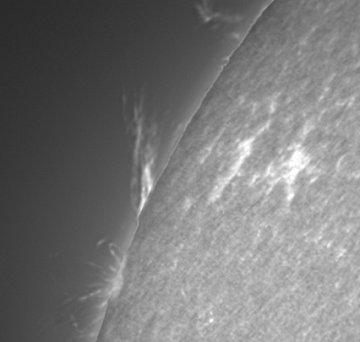
Lars Zielke took this picture on May 9th
from his backyard observatory in Tvis, Denmark. "I was
lucky to get some images of the new active region just as
it appeared over the sun's limb," he says. "In the
background there were some very nice prominences, so the
scene was set for a grand entrance."
Zielka used a
Lunt Ca-K
solar telescope. "Ca-K" means the telescope is tuned to
the purple glow of singly-ionized calcium. Such telescopes
are sensitive to the magnetic froth that often surrounds
sunspots and sunspot corpses. According to NASA's STEREO-B
spacecraft, which is stationed over the sun's eastern
limb, another active region should emerge today. Will it
be a genuine sunspot--or another corpse? Stay tuned.
photos:
from Stefano Sello of Pisa, Italy;
from Pete Lawrence of Selsey, West Sussex, UK;
from Mogens Nissen of Denmark;
from Matthias Juergens of Gnevsdorf, Germany;
from Howard Eskildsen of Ocala, Florida;
from Jesper Sorensen of Kastrup, Denmark;
from Tom King of Watauga, Texas;
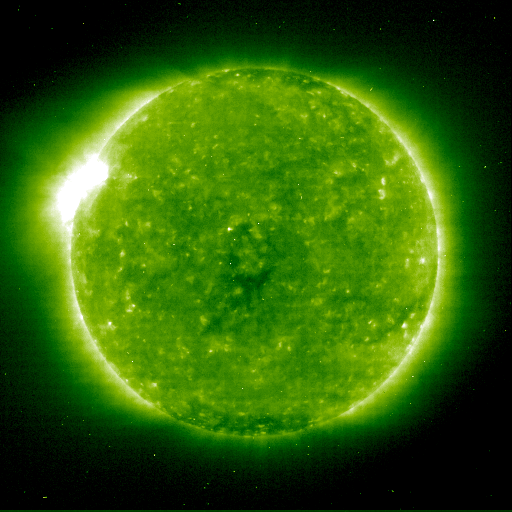
A minor solar wind stream
flowing from the indicated coronal hole should reach Earth on
May 12th or 13th. Credit: SOHO Extreme UV Telescope
|
5-8-09 - No sunspot today
Current conditions
Solar wind
speed: 493.5 km/sec
density: 1.6 protons/cm3
explanation |
more
data
Updated: Today at
2346 UT
X-ray Solar Flares
6-hr max: B1
2125 UT May08
24-hr: B1
2125 UT May08
explanation |
more
data
Updated: Today at:
2340 UT
HERE THEY COME: The
first of two new active regions, described
below, is emerging over the sun's northeastern
limb. Click on the links for photos:
from Pete Lawrence of Selsey, West Sussex,
UK; from
from Jesper Sorensen of Kastrup, Denmark
AROUND THE BEND: NASA's
STEREO-B spacecraft is monitoring a pair
of active regions hidden behind the sun's
eastern limb. They are the bright "hot spots"
in this photo taken by STEREO-B's extreme
ultraviolet telescope just a few hours ago:
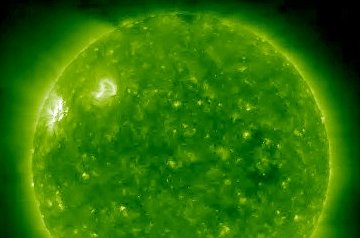
On May 5th and 6th, magnetic
fields in the vicinity of
these regions erupted, hurling
at least three coronal mass
ejections (CMEs) into space.
Since then, no explosions have
been observed. The sunspots
probably located at the base
of these active regions might
be in decay--or they might be
regrouping for a new round of
CMEs. We'll find out when the
sun's rotation turns the
active zone toward Earth for a
better view in the days ahead.
Readers with
solar telescopes should
train their optics on the
eastern limb.
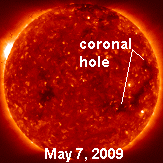
Earth is inside a solar wind
stream
flowing from the indicated
coronal
hole. Credit: Hinode X-ray
Telescope
|
5-7-09 - No sunspot today
Current conditions
Solar wind
speed: 465.2 km/sec
density: 1.3 protons/cm3
explanation |
more
data
Updated: Today at
2211 UT
X-ray Solar Flares
6-hr max: A0
2340 UT May07
24-hr: A0
2340 UT May07
explanation |
more
data
Updated: Today at:
2340 UT
|
5-6-09 - No sunspots today
Current conditions
Solar wind
speed: 363.8 km/sec
density: 6.0 protons/cm3
explanation |
more data
Updated: Today at 1246 UT
X-ray Solar Flares
6-hr max: A0 1245 UT
May06
explanation |
more data
Updated: Today at: 1245 UT
THE SUN IS
STIRRING: NASA's
STEREO-B spacecraft
is monitoring an active region hidden behind the sun's eastern
limb. On May 5th, it produced an impressive coronal mass
ejection (CME,
movie) and a burst of
Type II radio emissions caused by a shock wave plowing
through the sun's outer atmosphere. STEREO-B's extreme UV
telescope captured this image during the explosion:
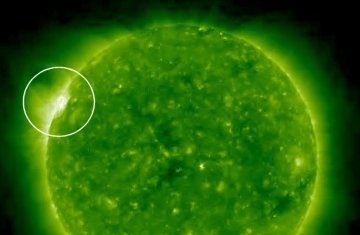
HERE IS A MOVIE OF THE BLAST THAT CAME FROM THAT SPOT -
YIKES!!!
http://www.spaceweather.com/swpod2009/07may09/CMEBurst_COR2_zm4.mov?PHPSESSID=cuu70b565soq4ao0cuub89cg97
At the root of all this activity is probably a sunspot. Its
high latitude identifies it as a member of new Solar Cycle 24.
The putative sunspot is not yet visible from Earth, but the
sun is turning the region toward us for a better view. Readers
with
solar telescopes should keep an eye on sun's northeastern
limb for an emergence on May 7th or 8th
METEOR ALERT:
Be alert for meteors before sunrise on Wednesday, May 6th.
Earth is passing through a stream of dusty debris from Halley's Comet,
the source of the annual eta Aquarid meteor shower. If you watch the
sky during the darkest hour before dawn, you could see an eta Aquarid
meteor every few minutes or so. Each one is a tiny piece of Halley's
comet
The eta
Aquarid
Meteor Shower
Forecasters expect the 2009 eta Aquarid shower to peak on
Wednesday morning, May 6th, with as many as
85 meteors per hour over the southern hemisphere. Sky watchers
in Australia, New Zealand, South America and southern Africa
are favored. Rates in the northern hemisphere will be less, 20
to 30 per hour. The best time to look is during the moonless
hour before local sunrise. That is when the shower's radiant
is high in the sky and the nearly-full Moon will have set,
leaving the sky dark for meteors.
Eta
Aquarids are flakes of dust from Halley's Comet, which last
visited Earth in 1986. Although the comet is now
far away, beyond the orbit of Uranus, it left behind a
stream of dust. Earth passes through the stream twice a year
in May and October. In May we have the eta Aquarid meteor
shower, in October the Orionids. Both are caused by Halley's
Comet.
The
shower is named after a 4th-magnitude star in the
constellation Aquarius. The star has nothing to do with the
meteor shower except that, coincidentally, meteors appear to
emerge from a point nearby. Eta Aquarii is 156 light years
from Earth and 44 times more luminous than the Sun.
The
constellation Aquarius does not rise very far above the
horizon in the northern hemisphere, and that's why northerners
see relatively few meteors. But the ones they do see could be
spectacular Earthgrazers. (continued below)
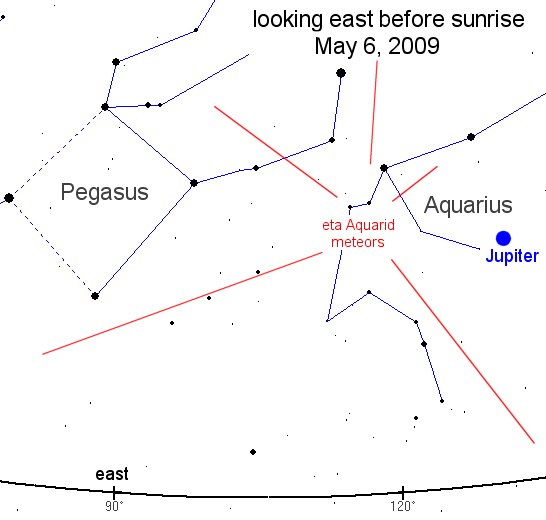
Sky maps:
Northern Hemisphere |
Southern Hemisphere
Earthgrazers are meteors that skim horizontally through the
upper atmosphere. They are slow and dramatic, streaking far
across the sky. The best time to look for Earthgrazers is
between 2:00 to 2:30 a.m. local time when Aquarius is just
peeking above the horizon.
Experienced meteor watchers suggest the following viewing
strategy: Dress warmly. Bring a reclining chair, or spread a
thick blanket over a flat spot of ground. Lie down and look up
somewhat toward the east. Meteors can appear in any part of
the sky, although their trails will point back toward
Aquarius.
Tidbits:
- Eta
Aquarid meteoroids hit Earth's atmosphere traveling 66 km/s.
-
Typical eta Aquarid meteors are as bright as a 3rd magnitude
star.
|
5-5-09 - No sunspots today
Current conditions
Solar wind
speed: 336.2 km/sec
density: 4.6 protons/cm3
explanation |
more
data
Updated: Today at
2346 UT
X-ray Solar Flares
6-hr max: A0
2335 UT May05
24-hr: A0
2335 UT May05
explanation |
more
data
Updated: Today at:
2340 UT
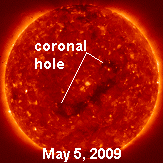
A solar wind stream flowing from
the
indicated coronal hole should
reach Earth on or about May 7th.
Credit: Hinode X-ray Telescope |
5-4-09 - No sunspots today
Current conditions
Solar wind
speed: 365.1 km/sec
density: 0.2 protons/cm3
explanation |
more
data
Updated: Today at
2159 UT
X-ray Solar Flares
6-hr max: A0
2340 UT May04
24-hr: A0
2340 UT May04
explanation |
more
data
Updated: Today at:
2340 UT
|
5-3-09 - No sunspots today
Current conditions
Solar wind
speed: 343.6 km/sec
density: 0.5 protons/cm3
explanation |
more data
Updated: Today at 2306 UT
X-ray Solar Flares
6-hr max: A0 2300 UT
May03
24-hr: A0 0140 UT
May03
explanation |
more data
Updated: Today at: 2300 UT
On Friday night, May 1st, a luminous X appeared on the Moon. "We
saw it easily through our 5-inch telescope," report Enzo De Bernardini
and Rodolfo Ferraiuolo of San Rafael, Argentina.
You may have to stare at the picture for a moment to see the X.
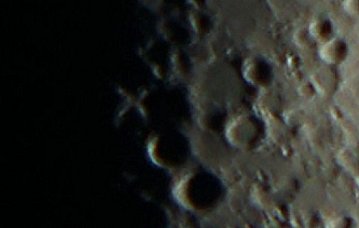
What is this "Lunar
X"? Once a month when the sun rises over Crater Werner in
the Moon's southern hemisphere, sunlight floods the region's
high terrain and makes a luminous criss-cross shape.
"Observing the X has little or no scientific value. It is a
trick of the light. But the effect is striking, and it is
exciting to rediscover each month," writes David Chapman in "A
Fleeting Vision near Crater Werner" (Journal of the Royal
Astronomical Society of Canada, Vol. 101, Issue 2, p.51).
The next apparition: May 31, 2009. Mark your calendar with
an X.
Source : May 1,2009 -
http://www.telegraph.co.uk/scienceandtechnology/science/sciencenews
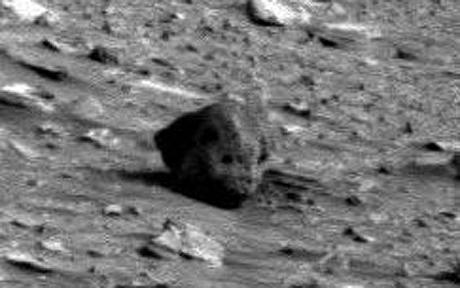
An oddly shaped space boulder appears to show eye
sockets and a nose leading to speculation it might be a
Martian skull .At first glance it looks like a rocky
desert - but this image of the Mars landscape has got
space-gazers talking.An oddly shaped space boulder appears
to show eye sockets and a nose leading to speculation it
might be a Martian skull.One alien-spotter speculated:
“The skull is 15 cm with binocular eyes 5 cm apart. The
cranial capacity is approximately 1400 cc. ”There appears
to be a narrow pointed small mouth, so this creature most
likely is a carnivore.” Another joked: “The coronal ridge
shows ample structure to support the musculature of
antennae, although none are visible in this view.” The nose
area is broad and blunted as you would expect to see in a
cold and windy landscape. Is he decapitated or is he
buried up to his neck?”Previous images of a skull spotted
on Mars in 2006 were believed to have been the result of
tampering.The famous Face on Mars, snapped by the Viking 1
spacecraft in 1976, which showed the shadowy likeness of a
human face was late, was found to be a trick of the light
when the area was re-photographed in 1998.
|
5-2-09 - No sunspot today - See photo below:
Current conditions
Solar wind
speed: 292.8 km/sec
density: 0.8 protons/cm3
explanation |
more data
Updated: Today at 1256 UT
X-ray Solar Flares
6-hr max: A1 0740 UT
May02
24-hr: A1 0740 UT
May02
explanation |
more data
Updated: Today at: 1245 UT
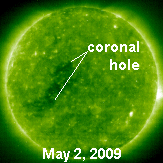
A solar wind stream flowing from the
indicated coronal hole should reach Earth on or about May 6th. Credit:
SOHO Extreme UV Telescope
SPACE WEATHER ON
MERCURY: Is it any surprise? The planet
closest to the sun is experiencing space weather events at a rate
10 times greater than anything we ever see on Earth. This is just
one of several new findings about Mercury announced in the May 1st
issue of Science magazine. Get the
full story from Science@NASA.
BLANKETY-BLANK SUN:
Sunspot 1016 has vanished. Yesterday it rotated over the western
limb of the sun where it can no longer be seen from Earth. But has
it really vanished? According to NASA's
STEREO-A spacecraft,
the sunspot still exists. It is circled in this extreme UV image
just beamed back to Earth:
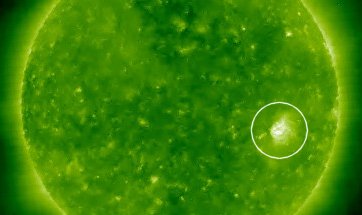
STEREO-A is
stationed
above the western limb of the sun. From that vantage point, the
spacecraft can track sunspots for days after they leave the range
of terrestrial telescopes. Back on Earth, the sunspot number has
dropped to zero, but STEREO-A is still counting.
So is the sun blank--or not? For more than 200
years, astronomers have counted spots on the Earth-facing side of
the sun and called that the sunspot number. Farside spots couldn't
be seen and didn't count. Continuing this tradition makes sense
because it allows us to compare data across the centuries. So,
today, the sun is
officially blank even if STEREO-A knows better.
AS THE WORLD
TURNS: Our planet is spinning, and here is
the proof:
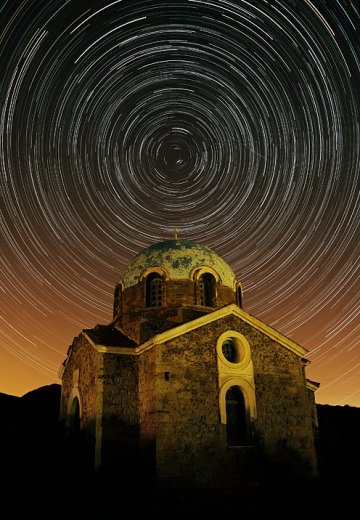
Chris Kotsiopoulos took the picture on April 26th. He placed
his camera (a
Canon Rebel XTi) motionless on a tripod in front of St. John's
church in Sounio, Greece, and opened the shutter for almost three
hours. The slow spinning of the planet beneath his feet caused the
stars above to trail in graceful arcs around the north star,
Polaris.
"Note the meteor to the right of Polaris," says Kotsiopoulos.
During the long exposure, a speck of space dust collided with
Earth's atmosphere and disintegrated in a straight line across the
arcs. The meteoroid was moving so quickly (~100,000 mph), it
didn't have time to curve before it faded away. Turns out that
stars
trail, but shooting stars
do not...
Student spots asteroid that slipped through the net
A Curtin University student has found a new asteroid
orbiting in our solar system, not far beyond Mars.
Honours student Mick Todd discovered the 4km-wide rock
while scanning the sky for dangerous nearby asteroids. The discovery is 300 million kilometres away. The object is part of the asteroid belt, a cloud of
cosmic boulders between the orbits of Mars and Jupiter. After checking the asteroid against databases, Mr Todd
realised it had never been spotted before.
|
5-1-09 - sunspot fading - going around the corner
Current conditions
Solar wind
speed: 287.9 km/sec
density: 0.1 protons/cm3
explanation |
more
data
Updated: Today at
2346 UT
X-ray Solar Flares
6-hr max: A0
2340 UT May01
24-hr: B1
0855 UT May01
explanation |
more
data
Updated: Today at:
2340 UT
DEPARTING SUNSPOT:
Sunspot 1016 is rotating over the sun's
western horizon today. It's going--"but not
quietly," reports Pete Lawrence of Selsey UK.
"The old-cycle active region is putting on
quite a show." Here is the view through his
SolarScope SF-70:
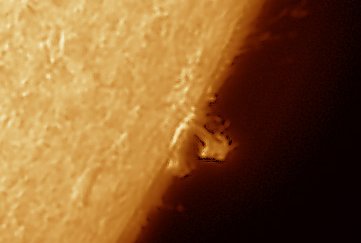
"It is a seething fury of
plasma," he says. "My images captured a
lovely, almost flower-like prominence ejected
from the region."
Readers, if you have a solar
telescope, train it on the sun's western limb.
Sunspot 1016 will be rounding the bend for the
next 24 hours or so. Parting shots are
welcomed.
more images:
from Didier Favre of Brétigny sur Orge,
France;
from Cai-Uso Wohler of Bispingen, Germany;
from Matthias Juergens of Gnevsdorf,
Germany;
|
